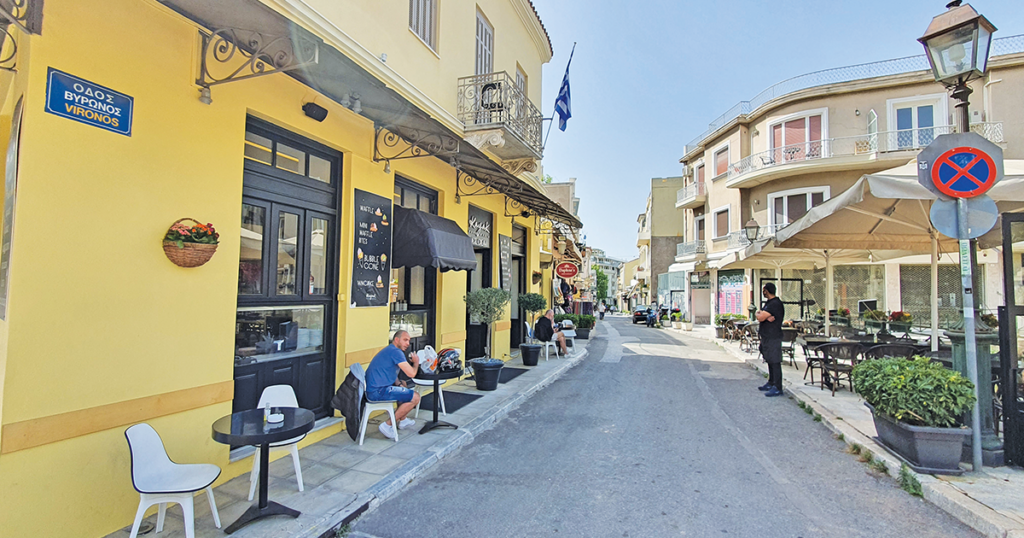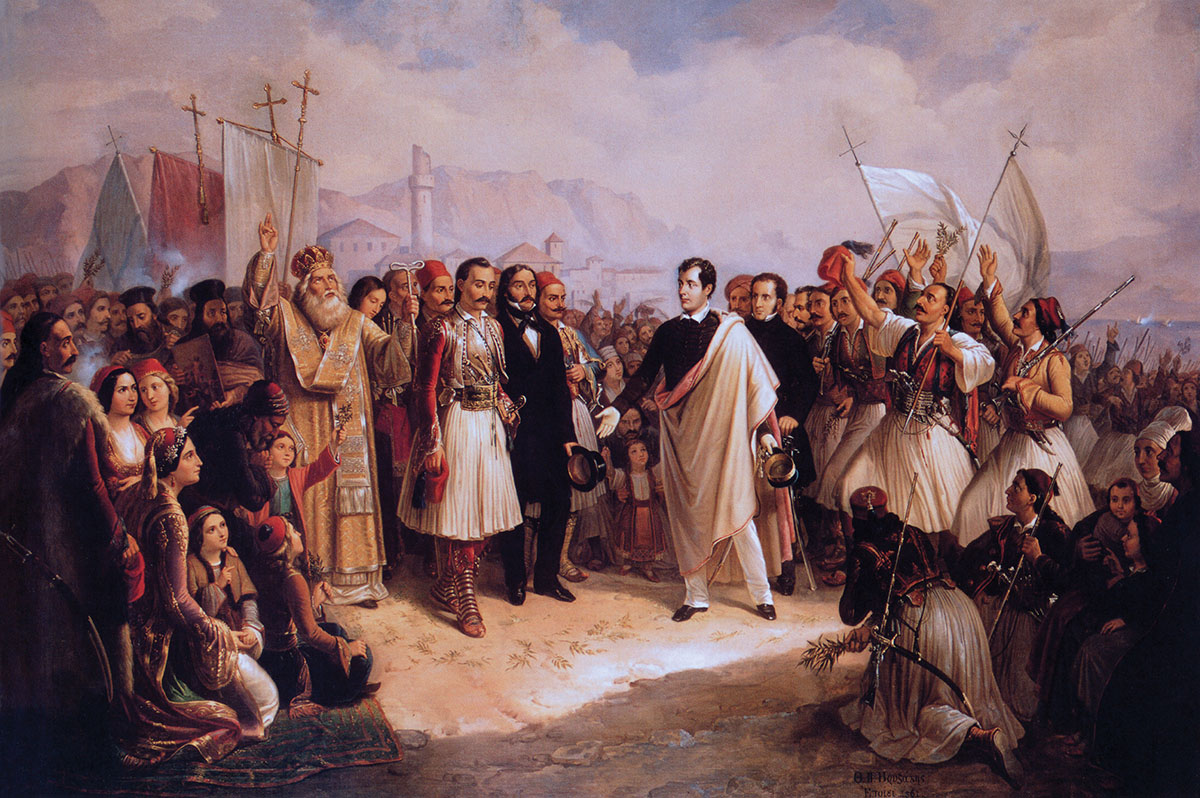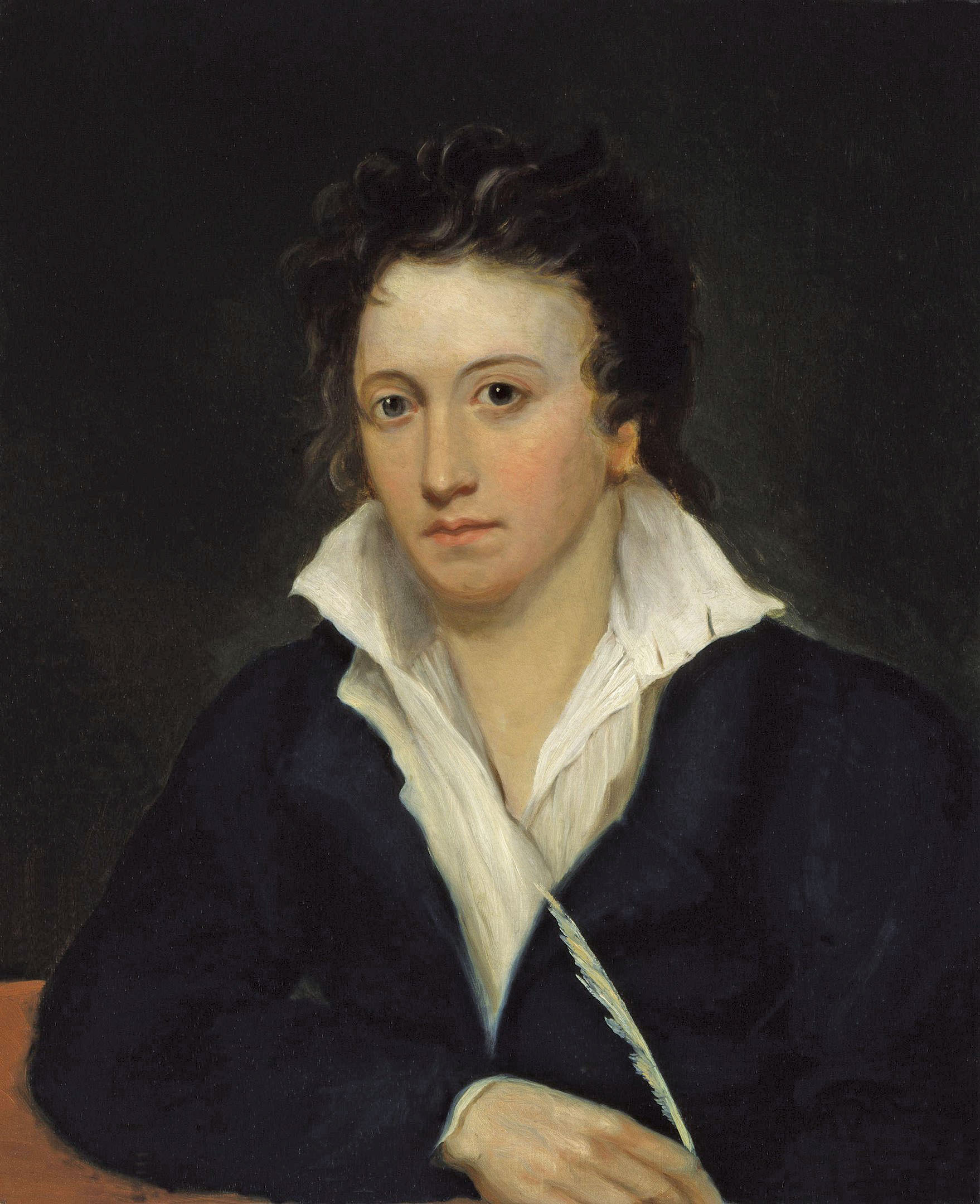
I was walking down Byron Street one day this past spring, heading to the post office in downtown Athens (an allowable outing under the lockdown—reason #2). It is a pleasant street, with one- and two-story neoclassical buildings in various stages of renovation or dilapidation, plus the odd souvenir shop and little hotel, leading up to the square of the Lysicrates monument, which was once used as a study in the Capuchin monastery. Lord Byron and his friend John Cam Hobhouse had stayed at the monastery in 1809. Byron Street abuts Shelley Street, both not far from the road known as the Street of the Philhellenes. Normally the area would have been thronged with souvenir-purchasing tourists, but Covid had left it strangely empty.
Byron works so nicely in Greek that it even has a declension. (The “Byron” of Byron Street—Vironos—is in the genitive.) Shelley, though, cannot even be written phonetically, since Greek lacks a “sh” sound. It takes a moment, looking at the street sign, to figure out what it is: Σέλλεϋ, “Selley.” Shelley remains distinctly foreign and un-Greek.
Walking along, I paused at the window of one of the antiques shops on Byron Street. On display were early-19th-century plates commemorating the heroes of the 1821 start of the Greek War of Independence. (The plates had been sold to support the Greek cause.) Two hundred years later, Greece is celebrating its bicentennial this year—although instead of parades and galas, exhibits and concerts, we have had the hush of lockdown. Even the one parade that did happen, on March 25, Greek Independence Day, was surreal, a parade complete with colorful costumes, horses, tanks, and warplanes but without onlookers: ordinary citizens had to watch on TV, although we could hear overhead the shudder of the helicopters and the booms of fighter jets ripping through the sound barrier.
One of the plates in the window depicted, as it happens, Lord Byron riding on horseback before a Greek detachment. (It is so labeled, in French.) Both the plate and the street name reminded me that few other revolutions have been so interwoven with poets and poetry. On a bicentennial mostly without pomp, poetry perhaps steps again to the fore.
Among Anglophones, it’s still fashionable to make something of a joke of Byron’s involvement in the Greek cause—to belittle his death by fever complications in marshy Messolonghi, for instance, instead of falling in battle. I hope that after a year of pandemic we can let go of that notion—the idea that fever is somehow a trivial way to die. The first deaths of the Iliad are not in battle, after all, but at the arrows of Apollo’s plague. In Greece, however, Byron’s death was never trivialized. In Athens alone, besides a Byron Street and a beautiful statue at the edge of the Zappeion Garden, there is an entire neighborhood, Byrona.
Byron had written about the Greek cause even before the revolution began, in Childe Harold’s Pilgrimage, the poem that made him rock-star famous overnight. And in his Don Juan, in Canto Three, we have a stand-alone lyric, a song within a song, “The Isles of Greece,” with its linking of the ancient battles of Marathon and Salamis and Thermopylae to the idea of contemporary liberation:
The mountains look on Marathon—
And Marathon looks on the sea;
And musing there an hour alone,
I dream’d that Greece might still be free;
For standing on the Persians’ grave,
I could not deem myself a slave.A King sate on the rocky brow
Which looks o’er sea-born Salamis;
And ships, by thousands, lay below,
And men in nations;—all were his!
He counted them at break of day—
And when the Sun set, where were they?
Byron puts this song in the voice of a Greek poet who is used to singing according to the preferences and politics of his audience; in this case, Byron says, he has made a truce with truth. Even at their most abstract and idealized, the lyrics are put into a specific, if fictionalized, modern Greek context, and in the voice of an unreliable narrator.
Byron’s is a singular case, though, where the life (and the death) and the work blend into each other, fiction becoming fact and vice versa. His death on April 19, 1824—symbolically for the Greeks because it was the day after Easter—was a galvanizing event for the cause in Greece and abroad, and for poetry and Greek letters. Spyridon Trikoupis, who would become the first prime minister of the Greek state after independence, capitalized on his death by delivering a rousing funeral oration, which was widely translated and disseminated in Europe.
A young Italian-educated poet in Zakynthos, Dionysios Solomos, was perhaps the first Greek poet to bring Byron into Greek literature. Trikoupis had persuaded Solomos to give up writing poems in Italian and focus instead on writing in demotic Greek—Italian already had its Dante, Trikoupis said, but modern Greek did not. On hearing of Byron’s death, Solomos apparently began spontaneously declaiming the beginning of a new poem to his companions:
Liberty, stop for a moment
Striking with your sword,
And come and weep
Over the body of Byron.
Over the next months, even years, Solomos continued to add quatrains to his lyrical poem on the death of Lord Byron, ending up with more than 160 of them. Set to music by Nicholas Mantzaros, it became a popular nationalist song.
Solomos also wrote the “Hymn to Liberty”—in similar quatrains and in the same period—which, also set to music by Mantzaros, would become the Greek national anthem. At 158 stanzas, its lyrics are the longest of any national anthem. In it, Solomos transforms lines from Byron’s Don Juan about the troop of dancing Grecian girls:
Our virgins dance beneath the shade—
I see their glorious black eyes shine;
But gazing on each glowing maid,
My own the burning tear-drop laves,
To think such breasts must suckle slaves.
Solomos translates these lines but makes some changes in keeping with the hymn’s optimism—the breasts are destined not to suckle slaves; rather, Solomos’s soul rejoices, they prepare the milk of courage and freedom. Nobody sings all the stanzas, of course—just the first few. In the Daily Telegraph of October 17, 1918, less than a month before the Armistice of World War I, Rudyard Kipling published a translation of the opening of the “Hymn to Liberty” into English. It begins, as the Byron poem does, with Liberty and her Sword:
We knew thee of old
Oh divinely restored
By the light of thine eyes
And the light of thy SwordFrom the graves of our slain
Shall thy valour prevail
As we greet thee again—
Hail, Liberty! Hail!

Byron’s arrival in Greece on Christmas Eve, depicted here in Arrival Of Lord Byron In Messolonghi by Theodore Vryzakis, added to the poet’s legacy as the nation’s savior. (Pictures Now/Alamy)
Byron as a theme for Greek poets continued through the 19th century, with a flurry of interest in 1924, the centennial of his death. The poet and his sacrifice for liberty might have had a new resonance in 1924; in March of that year, Greece became a republic rather than a monarchy and was still reeling from the Asia Minor Catastrophe, which had sent 1.5 million refugees, ethnic Greeks, flooding into the country in the population exchange with Turkey. War was not a distant abstraction.
Among those writing Byron poems in this period was another national poet of Greece, Kostis Palamas, who composed “Byronolatry” (Byron-worship) and a charming lyric in which Byron’s mount is none other than Pegasus, which in the poem has the power of speech, like Achilles’s immortal horses. In this flight of poetic fancy, Palamas himself rides off in Pegasus’s diamond saddle, planning on greater heights even than Byron.
If Palamas gives Byron a mythological steed, he is only following Byron’s lead. Byron himself has “ridden” Pegasus throughout Don Juan:
If that my Pegasus should not be founder’d,
I think to canter gently through a hundred [cantos].
(It seems likely that Byron, who had a lame leg and enjoyed riding, composed on horseback the way so many other Romantic poets did walking.)
Kostas Karyotakis, the doomed modernist genius of Greek letters, seems an unlikely poet to produce a Byron poem, but he also composed one for 1924, a sort of dimeter sonnet (this is my own free translation):
Byron
He realized
His lines of verse
Were joyless luck,
In vain, or worse.But there on the walls
What splendor and truth,
There by the lagoon,
What glorious youth!Old men grow bold;
The flower of men
Is spurred along,And Byron knows
How to live
The divine song.
Karyotakis would commit suicide only four years later; failing to drown (like Byron, he was a strong swimmer), he shot himself in the heart.
Enough Greek poetry about Byron exists to supply an anthology, much of it stemming either directly from his death or from the centennial observations. But I still stumble across the odd recent poem. I was charmed to hear one in 2018 at the fourth Athens World Poetry Festival, where I participate, somehow, as both a foreign poet and a local one. A poet named Antonis Makrydemetres, born in Corinth in 1955, read “Byron: 19.4.1824”—it is pure Byronolatry. I am assuming this is his own translation. It ends,
You did not survive to see Her [Liberty]
Walking barefoot on the ancient soil
Amongst the ruins most beautiful and lonelyHellenes and Greeks adore you ever since
Noble Lord Byron for your sacrifice for them
And will glorify you in eternity.
A Byron Street in Athens makes sense. But a Shelley Street? Although he never set foot in Greece, Shelley contributed verse to the cause. In 1821, influenced by Aeschylus, Shelley composed a verse drama, Hellas, now mostly remembered for its final chorus. An indication of how entangled the poetry and the politics were, its dedicatee is a Prince Alexandros Mavrokordatos, who was exchanging Greek for English lessons with Mary Shelley. A statesman active in the cause, Mavrokordatos would become the young nation’s first premier.

Athens also has a street named for Shelley. He never set foot in Greece, but his poetry supported the cause. (Wikimedia Commons)
The drama is a contemporary recasting of Aeschylus’s The Persians, the oldest Greek tragedy we have, one set not long after the decisive battle of Salamis. If the dedicatee of Hellas requires a footnote for English readers, then for Greek speakers it is possibly Shelley who requires a footnote in the cause of 1821. Who now reads this poem? And who in Greece, at least until recently, had read it at all?
But there is revived interest in the poem here, owing to a new translation for the bicentennial by the Greek poet Orfeas Apergis, who has put Shelley’s verses into flowing Greek meter and rhyme. One of the first things Apergis points out is, why “Hellas” and not just “Greece”? Byron, for instance, does not have “Isles of Hellas.”
Apergis concludes that Shelley is actually a philhellene-skeptic:
Although I started out to translate wanting to do a full and proper “nationally interesting and interested” commemoration of a great philhellene, who is not so well-known in Greece (if at all, compared to Byron) … I realised as I was doing it, and after I finished it, how skeptical a philhellene Shelley really was, in that, despite the obvious and expected mythologising of all things “ancient Greek,” he describes the Revolution through the eyes of the Turks (the Sultan and his entourage, in the manner of Aeschylus’ Persai), and, in so doing, he ends up portraying … the “poetically beautiful” horrors of battle and thus seems to pity the Turks and their Sultan, who is caught in the maelstrom of the inexorable progression of History.
Byron’s particular immersion in Greece, and Shelley’s abstraction and universalization of it, can be summed up in two quotations, Byron’s “If I am a poet … the air of Greece has made me one,” and Shelley’s own statement in his preface to Hellas: “We are all Greeks. Our laws, our literature, our religion, our arts have their root in Greece.”
Shelley ends his verse drama with a poetic prophesy—a golden age, outside of, or even at the end of, history—it could be the end of the world, rather than the prosaic practicality of obtaining and maintaining Greek independence, which, in separate ways, both Byron and Mavrokordatos would wrestle with. When Shelley says, “Another Athens shall arise,” we know he does not mean the physical Athens where, in the 21st century, there will be a Shelley Street branching off Byron Street, in the center of a busy city, under the shadow of the Acropolis. It is an idea of liberty that is itself freed from nationalism, from time and place.

